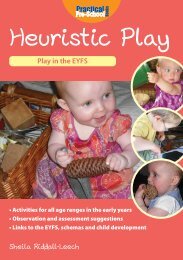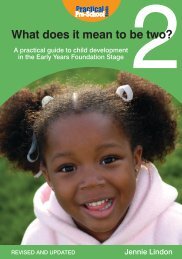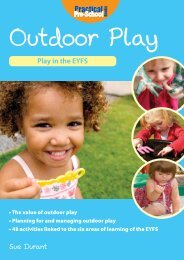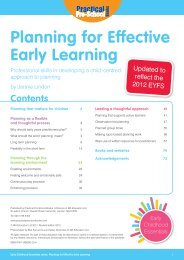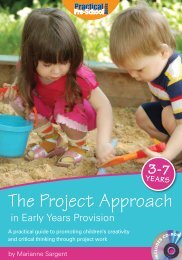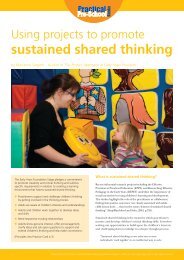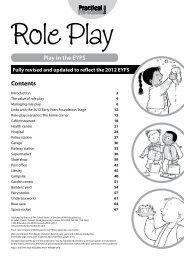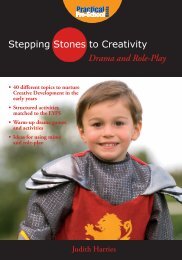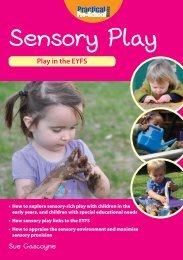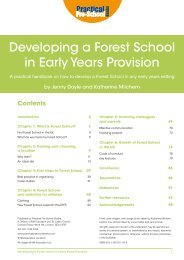What does it mean to be one? - Practical Pre-School Books
What does it mean to be one? - Practical Pre-School Books
What does it mean to be one? - Practical Pre-School Books
You also want an ePaper? Increase the reach of your titles
YUMPU automatically turns print PDFs into web optimized ePapers that Google loves.
mother did. They im<strong>it</strong>ated their mother’s expression but were also active in their<br />
own facial expressions and waving hands and feet.<br />
• Babies were able <strong>to</strong> pause and look expectant. They had learned something of the<br />
timing of a conversation, <strong>be</strong>cause their mother communicated regularly in this way.<br />
• Babies reacted <strong>to</strong> changes in their mother’s <strong>to</strong>ne. They were also very aware if<br />
their mother’s attention was distracted, as was sometimes deli<strong>be</strong>rately created by<br />
an interruption in some studies. Babies made physically active and sound-making<br />
attempts <strong>to</strong> regain her full attention.<br />
• There was also evidence that the babies had a subtle grasp of the give-and-take of<br />
a proper exchange. When babies were shown a video of their mother, they soon<br />
changed from happy communication <strong>to</strong> signs of confusion, and then distress. The<br />
only interpretation was that the reactions of the familiar face on the screen failed<br />
<strong>to</strong> f<strong>it</strong> what the baby had just ‘said’. The timing was awry, the video of the mother’s<br />
reactions were not attuned <strong>to</strong> the emotional <strong>to</strong>ne of her real baby. Young babies very<br />
soon <strong>be</strong>came aware of the mismatch.<br />
The 1970s and 1980s studies used mother and baby pairs and called the subtle adult<br />
communication w<strong>it</strong>h babies ‘motherese’. However, this kind of adjusted communication, that<br />
is so very su<strong>it</strong>able for babies, is not the sole terr<strong>it</strong>ory of mothers, nor of women. Nor is the<br />
communication style used only by parents, so ‘parentese’ is not much of an improvement as<br />
a term. Men, as fathers or early years pract<strong>it</strong>i<strong>one</strong>rs, are completely capable of adjusting their<br />
communication in this way. So <strong>it</strong> is <strong>be</strong>tter called a phrase like ‘infant-directed speech’. Older<br />
children, who probably copy familiar adults, also sometimes produce this kind of talk w<strong>it</strong>h babies<br />
they know, not always their own siblings. The delighted reaction from the baby is encouragement<br />
<strong>to</strong> continue.<br />
The characteristics of effective infant-directed speech are as follows:<br />
Being a helpful adult<br />
The video-based research of<br />
babies is three decades old, but as<br />
relevant as ever. The v<strong>it</strong>al insights<br />
about early communication and the<br />
sens<strong>it</strong>iv<strong>it</strong>y of babies are applicable<br />
<strong>to</strong> the exchanges <strong>be</strong>tween caring<br />
adults (of e<strong>it</strong>her sex) and a baby.<br />
• Even babies of a few months<br />
old are keen <strong>to</strong> communicate.<br />
They are responsive <strong>to</strong><br />
affectionate attention from an<br />
adult – and also from familiar<br />
older children, who can <strong>be</strong> very<br />
patient in chatting w<strong>it</strong>h babies.<br />
• Babies’ alertness at this stage<br />
is based on hearing familiar<br />
voices, reassuring talk and<br />
singing from the earliest weeks.<br />
• The adult needs <strong>to</strong> stay close<br />
and never see communication<br />
w<strong>it</strong>h a baby as something<br />
that can interrupted by more<br />
‘important’ tasks.<br />
• You have <strong>to</strong> <strong>be</strong> close <strong>to</strong> babies so that your faces are in close proxim<strong>it</strong>y and they can<br />
see your eyes and facial expression. You might <strong>be</strong> chatting in this way as you change<br />
their nappy, s<strong>it</strong>ting w<strong>it</strong>h them on your lap or <strong>be</strong>side them as they lay on their back on<br />
a comfortable floor.<br />
• It <strong>does</strong> not matter what you say, so long as you look interested. Use ordinary words,<br />
there is no advantage, and some drawbacks, if you introduce ‘baby talk’ and change<br />
words, like saying ‘bikky’ or ‘gee gee’.<br />
• Keep what you say simple and your phrases short. Pause and look expectant, so that<br />
the baby learns <strong>it</strong> is now her turn <strong>to</strong> ‘say’ something.<br />
• Be more expressive than in usual speech, both in how you say the words and in your facial<br />
expressions. Use your eyes, mouth and facial muscles <strong>to</strong> add <strong>to</strong> the communication.<br />
• Babies seem <strong>to</strong> like voices <strong>to</strong> <strong>be</strong> slightly higher p<strong>it</strong>ched than the normal adult <strong>to</strong>ne. On<br />
average, women have a higher p<strong>it</strong>ched voice, but men can go up a b<strong>it</strong> in p<strong>it</strong>ch w<strong>it</strong>hout<br />
straining or sounding odd. For instance, watch three-month old Charlotte and her father,<br />
as he changes her nappy and chats, in Firm foundations for early l<strong>it</strong>eracy (Siren Films 2009).<br />
• <strong>What</strong> works <strong>be</strong>st is sing-song style, w<strong>it</strong>h a circling and repet<strong>it</strong>ive qual<strong>it</strong>y. You repeat<br />
or half-repeat a phrase that has caught the baby’s attention, such as, ‘Is that a<br />
rasp<strong>be</strong>rry? Did you blow a rasp<strong>be</strong>rry at me?’<br />
• Follow a relaxed rhythm, so the baby has the time <strong>to</strong> express their sounds, make<br />
their facial expression or wave their hands at you. If you go <strong>to</strong>o fast, then you end up<br />
talking over the baby’s contribution <strong>to</strong> the conversation.<br />
• Be ready <strong>to</strong> follow the baby’s lead, in sounds or facial expression. You are partners in<br />
this exchange and <strong>it</strong> is a delight <strong>to</strong> babies (and <strong>to</strong>ddlers as well) when you copy them.<br />
<strong>What</strong><br />
<strong>does</strong><br />
<strong>it</strong> <strong>mean</strong> <strong>to</strong><br />
<strong>be</strong><br />
<strong>one</strong>?<br />
17<br />
<strong>What</strong><br />
<strong>does</strong><br />
<strong>it</strong> <strong>mean</strong><br />
<strong>to</strong><br />
<strong>be</strong><br />
<strong>one</strong>?




